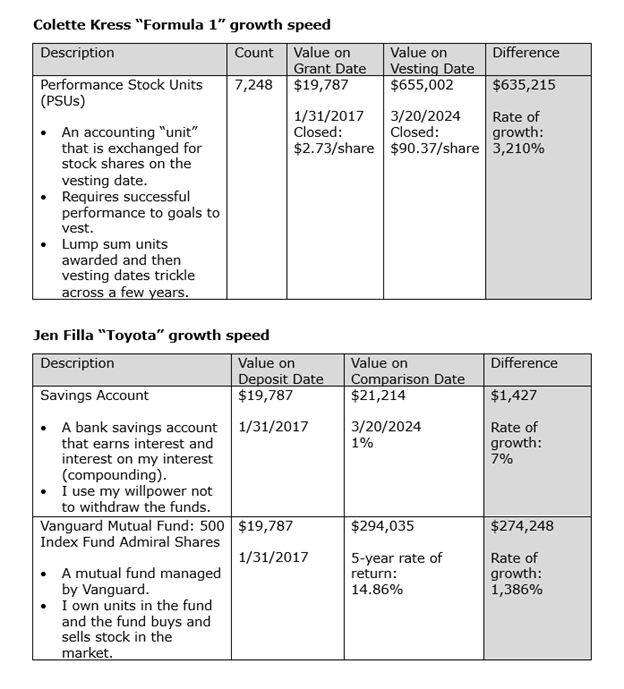Most of us are familiar with getting a paycheck as well as the practice of receiving a bonus incentive for achieving top performance. And many people are familiar with investing in mutual funds to benefit from the stock market without having to manage a personal portfolio. But exactly how is it that public company insiders can accumulate such tremendous wealth? Is it just because the total numbers are bigger?
I have always thought of stock options and stock grants as the “paycheck that keeps paying.” If the company’s stock price continues to rise – and perhaps rise dramatically – the original option or stock value also increases.
In my head I imagine I have my Toyota at the starting line with the insider’s Formula 1 race car next to me. Sure my “Toyota” mutual fund rate of return is awesome, but the insider’s “Formula 1” performance stock units can go so much faster!
But how does the insider make incredible gains on their incentive awards in real life?
NVIDIA Corp. (NASDAQ: NVDA) chief financial officer Colette Kress is our obliging volunteer with a demonstration below.

The savings account is not even a real comparison is it? In that scenario, my Toyota is more like a beat-up, barely moving, 20-year-old Toyota compared to the insider’s Formula 1 – and that is with what has been a generous, harder to get 1% rate!
But when we get to a double-digit rate of return on the mutual fund – which is invested in the stock market – we see something close to a comparison to the NVIDIA stock rise — but not really. Why? Because NVIDIA stock rose in value faster and I had to make the initial investment. Ms. Kress was given the stock for her performance. Yup. The paycheck that keeps paying!
At this point someone usually reminds me that stock prices can go down, too.
This is true. But for a public company executive insider like Colette Kress, she earns a cash salary and bonus every year too, which has been around $897,000 from 2022 through 2024.
Her Performance Stock Units are a long-term incentive (i.e., long-term bonus). She receives her annual salary and short-term bonus in cash and her long-term incentive in performance stock units (PSUs), which vest into stock a little bit each year — adding a very generous layer of stock value.
This is Why I Say That Long-Term Incentives are Like the Paycheck that Keeps Paying
Hopefully, this example gives you a better perspective of how stock is an outsized addition to salary and cash incentives in the compensation package. And it is not just the executives who receive stock as part of their compensation package.
Top executives are considered insiders and must publicly report their compensation, but management and other employees likely receive stock awards, too. Just not quite so many!
When your prospect is a public company insider this automatically indicates the potential for significant wealth.
To know how much – or how little – requires some knowledge and skill. This is where the prospect research professional steps in to clearly present the full wealth picture of a prospect.
If you are looking for training on how to assess public company insider wealth from Securities and Exchange Commission (SEC) filings, check out the training offered at the Prospect Research Institute!
 Curious about compensation and beneficial ownership, but also how to incorporate into capacity and the profile? This 3-workshop bundle has you covered! Enroll Now
Curious about compensation and beneficial ownership, but also how to incorporate into capacity and the profile? This 3-workshop bundle has you covered! Enroll Now
Want to know more about insiders? Check out “Why Insiders” by Elisa Shoenberger.

One thought on “Insiders and the Paycheck that Keeps Paying”
Comments are closed.